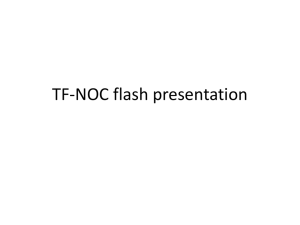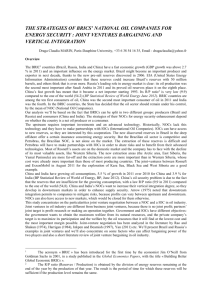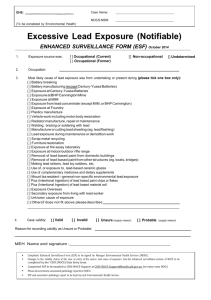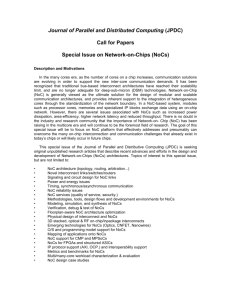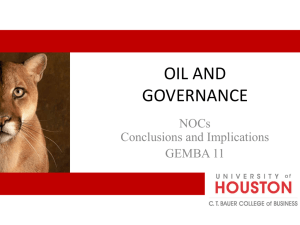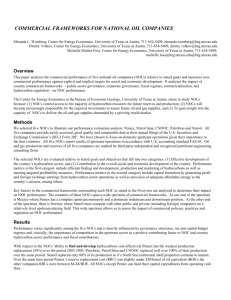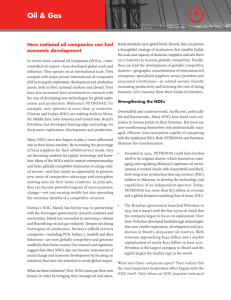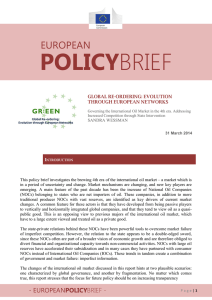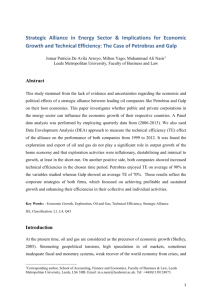Investing in and Financing the Hydrocarbon Sector to Enhance
advertisement
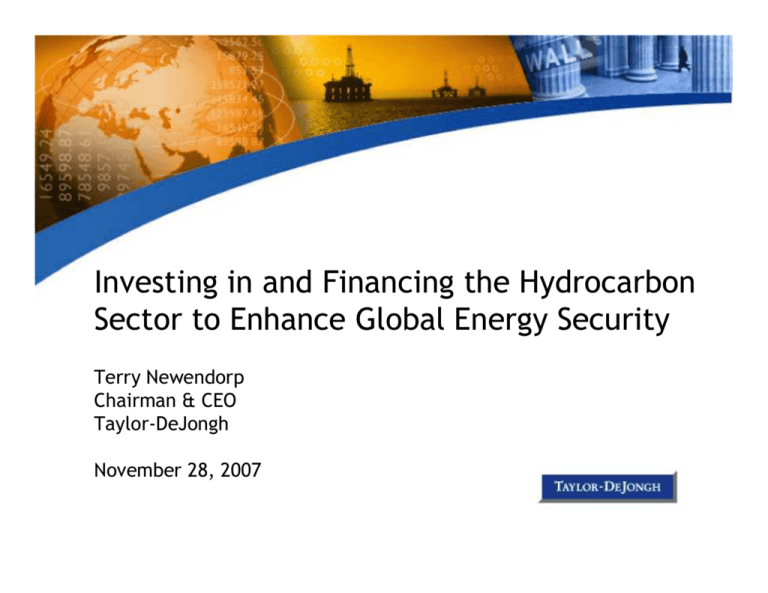
Investing in and Financing the Hydrocarbon Sector to Enhance Global Energy Security Terry Newendorp Chairman & CEO Taylor-DeJongh November 28, 2007 1 Agenda I. Taylor-DeJongh II. Energy Security & Investment Requirements III. Changing IOC-NOC Roles IV. Government Roles in Energy Investment V. Financing Energy Infrastructure VI. Conclusions & Recommendations 2 Taylor-DeJongh In Brief • TDJ is an independent, specialist investment banking firm focused on energy, oil & gas and infrastructure. • More than 25 years of successes in bringing the highest quality of independent, objective service to meeting its clients’ capital needs. • #1 ranked Oil & Gas project finance advisor – 4 years running. Core Expertise Oil & Gas Pipelines LNG Power Generation GTL Metals & Mining Petrochemicals and Refineries 3 Energy Security by Means of Investment • The most effective way to manage supply risk and increase global energy security is to invest in technology and infrastructure: – Ensure that available resources are fully exploited. – Diversify sources and types of energy supply. – Create flexibility of transportation and delivery infrastructure. • Changes in the energy market have given rise to new challenges in meeting these investment requirements. – – – – Shifting Supply and Demand Centers. Access to Resources. NOC Expansion and Internationalization . Above-Ground Investment Risks. Active cooperation between IOCs and NOCs, together with stable host government policies, can help ensure that the required capital is mobilized in support of hydrocarbon investments. 4 Global Capital Requirements • Global energy capital requirements will exceed US$ 21.9 trillion through 2030. Equals 47% of the world’s current GDP. Cumulative Investment in Energy Supply Infrastructure, 2006-2030 Latin America Coal Oil Africa • Investments are shifting towards the developing world: – 62% of upstream investment through 2030 will be in nonOECD countries. – China is the fastest-growing refinery market in the world. – Nearly 50% of new pipeline capacity will be located in Africa, the Middle East, and Asia. – LNG liquefaction capacity overwhelmingly comes from Africa, the Middle East, and Asia. Gas Power Middle East Developing Asia Transition economies OECD Billion US$ 0 1000 2000 3000 4000 5000 6000 7000 8000 Source: IEA World Energy Outlook 2007 5 New Actors • NOCs have full control of 65% of global oil and gas reserves and effective control over another 12%. • Leveraging control over reserves and their dominance in domestic markets, NOCs have been expanding – both by means of greater vertical integration and through international expansion: – PDVSA plans to double domestic refining capacity and decrease dependency on the U.S. – QP has partnered extensively with IOCs for its verticallyintegrated LNG projects. NOC objectives – whether it is to seek national energy independence or to build international partnerships – will shape global energy security. 6 NOC Efficiency & Investment Levels • Despite holding 10x the amount of hydrocarbon reserves as IOCs, NOCs only produce 2.3x as much oil and gas. • Case studies of domestic refinery markets and monopoly-controlled upstream sectors are indicative of frequent NOC underinvestment. Selected Revenues per barrel of oil equivalent (boe) 40 20 10 Co no c To t oP al hi lli Ch ps ev In E ro de n pe xxo ne nM nt ob A v il er ag e S NO ta t C A v oil er ag e Pe Pe mex tr ob ra CN s OO C Lu k Pe oil tr on as So na ng ol P Sa DV ud SA iA ra m Ga co zp ro m IO C M aj or s Av BP er ag e Sh el l ar at ho n 0 M $/boe 30 Source: Eller, Hartley, Medlock, “Empirical Evidence on the Operational Efficiency of National Oil Companies,” 2007 7 IOC-NOC Strategic Objectives NOC partners often have both commercial and non-commercial objectives. For successful cooperation, partners must remain cognizant of each other’s objectives. • • • • • • • IOC Objectives Access to: – Reserves; – Government; – Customers/Markets; – Investment Incentives. Economies of scale. Avoiding “resource nationalism.” Sharing of risk. Diversification of asset portfolio. Competitiveness. Maximize shareholder value. • • • • • • NOC Objectives Access to: – Downstream Markets; – Technology; – Skilled Personnel; – Trading rights; – Capital. Improved efficiency. Attracting investment. Knowledge transfer, employment. Economic development. Fulfill national government priorities. 8 Changing IOC-NOC Roles • A class of “entrepreneurial NOCs” has emerged. These NOCs are increasingly technologically sophisticated and commercially successful. Technology Provider • Entrepreneurial NOCs balance political and commercial objectives to improve their efficiency. IOCs Statoil Petrobras Petronas • Successful NOC reform policies have included: – – – – Saudi Aramco Qatar Petroleum Resource Seeker Increased competition; (Partial) Privatization; IOC Partnerships; R&D Investment Programs. Pemex CNOOC PetroChina ONGC Gazprom Resource Provider PDVSA NNPC NOC Technology Seeker IOC Entrepreneurial NOC Source: SAIC Analysis in Oil & Gas Journal, “Oil companies adjust as government roles expand,” March 2007 9 Government Policies to Promote Investment • Most energy infrastructure projects involve long-term investment horizons. Consequently, stability of the investment climate is a critical concern for lenders and sponsors. • Midstream projects are closely linked to upstream counter-parties. Policies toward upstream sector and midstream are equally important. • Frequent legislative changes, creeping or outright expropriation, and dramatic tax increases can act as disincentives to investment, or could result in higher borrowing costs due to the country’s perceived political risk. High oil and gas prices have encouraged investors to enter into riskier projects. Should prices fall, some policies adopted to take advantage of the current market could negatively impact future investment levels. 10 Rise of “Resource Nationalism” • Recent investor conflicts in such countries as Russia, Kazakhstan, Algeria, Bolivia, and Venezuela feeding into global trend. Cases of tighter terms, new laws, renegotiations, and new NOCs Source: PFC Energy, April 2007 11 Financing Hydrocarbon Investments • There exists a wide range of funding sources for energy infrastructure, and liquidity is high in light of current energy prices. • Sources used in financing energy infrastructure depend on the individual investment project. – Upstream projects are typically funded from the balance sheet because lenders will not accept exploration risk. – Midstream projects such as LNG terminals, refineries, and pipelines are frequently large-scale projects, and usually require some debt component. – Integrated mega-projects like the Qatargas LNG deals have employed project finance to structure a multiple types of capital and allocate project risks. 12 Investment in the Oil & Gas Value Chain Investments in Exploration & Production • Meeting these investment needs will require a variety of sources of finance, including: – – – 250 Billion US$ • Total Oil & Gas investments are expected to reach US$ 8.9 trillion from 2005-2030 (or 19% of the world’s GDP), of which over half will be in upstream developments. 300 5 M ajors OPEC NOCs Independents Non-OPEC NOCs 200 150 100 50 0 2003 2004 2005 2006 Source: Total SA, “NOC-IOC: Competition or cooperation?” Strategic Investors: Based on company investment plans, oil & gas investment will rise from US$ 340 billion in 2005 to US$ 470 billion in 2010. 67% of this amount will consist of upstream investments. Private Equity: As of January 2007, there exists an estimated US$ 30 billion in energy-dedicated private equity. Project Finance: Oil & gas projects accounted for US$ 32.3 billion of project debt in 2006, or 17.3% of total project finance lending. Power projects made up an additional 30%. 13 Sources of Energy Infrastructure Finance Strategic Equity Corporate Unsecured Private Public Bank debt Corporate Secured Project Finance Sponsor Senior Debt EXIM ECAs SACE / Other EU JBIC Mezzanine European Bonds US 14 Structuring Energy Investments: Project Finance • Project finance involves financing of capital assets based solely on the cash flow generated by those assets. Project finance offers only limited recourse to the sponsor’s balance sheet. As a result, it is attractive because it: – Increases leverage, thereby enabling partnership with smaller IOCs and capital-constrained NOCs; – Eliminates cross-subsidies, ensuring that each investment is selfsupporting; – Allocates project risk; – Prices the cost of capital for a specific risk; – Focuses accountability. • NOCs like Petrobras and QP have successfully used project financing as part of their overall financial strategy, funding their international expansion and lengthening their debt tenor. This policy has ultimately led to credit rating upgrades and improved access to capital. 15 Typical Project Finance Structure Sponsors Lender Consortium Shareholder Agreement Financing Documents SPA Supply Contract Project Company Feedstock Supplier Offtaker Concession Agreement, Licenses, etc. Host Government Site Lease/Sales Agreement EPC Contract O&M Contract Site Provider EPC Contractor Operator 16 Global Project Finance Lending • In the first half of 2007, Oil & Gas Project Finance loans were ranked only fourth by sector in terms of proceeds and number of issues. • In EMEA, Oil & Gas is ranked only #7 in terms of size of loan proceeds with negative growth relative to 1H2006. Property loans, on the other hand, have increased by over 11%. Global Project Finance Loans by Top 5 Sectors, First Half Global Project Finance Lending 40.0 2003 2004 2005 2006 1/1/2006-6/30/2006 30.0 102 145 166 210 By Type Bank 1/1/2007-6/30/2007 35.0 70 116 140 181 Billion US$ US$ billion 25.0 20.0 15.0 10.0 5.0 Bond 32 29 26 29 - Power Transportation Leisure & Oil & Gas Petrochemicals Property Source: Project Finance Source: Thomson Financial League Tables 17 Case Study: Petrobras • Founded in 1954 with a monopoly over the full energy value chain. • Liberalization began in 1995, culminating in partial privatization and listing on the NYSE. • Privatization has led to significant operational improvements: – – – Petroleum output has doubled since 1997, and Petrobras has expanded to 27 countries. Capital expenditures have quadrupled from $4 billion in 1999 to nearly $16 billion in 2006. Petrobras is the world’s largest deepwater producer, and the only company with operator status to have drilled, tested, and evaluated pre-salt rocks, leading to a major discovery in the Tupi accumulation. • Joint Ventures with IOCs and other NOCs are a key component in the company’s operations due to the high costs of its deepwater portfolio. – – As of December 31, 2006, Petrobras has JVs with 25 foreign and domestic companies for its Brazilian E&P activities. The NOC is involved in 87 Operational Partnerships Contracts, and is operator on 62 of these. Participation ranges from 20-90%. • Although 80% of reserves located offshore, deepwater E&P focus did not begin until mid-1980s. 18 Case Study: Petrobras Financing Strategy Financing Strategy: Lengthening of debt profile and reduction of debt costs. • At time of full market liberalization, Petrobras’ cost of capital was more than 2x that of companies like Shell, Total, and Eni. • Project finance has been a key element of the strategy, contributing to higher leverage and lower borrowing cost. 100% 80% 60% 40% 20% 0% Dec-01 Dec-02 Dec-03 Dec-04 Dec-05 Dec-06 Commercial Bank Debt Domestic Bonds Project Finance Securitization Platform/Sale Lease Back BNDES 1Q07 2Q07 International Bonds Export Credit Agencies Other • As a result of successful implementation of its strategy and an increased emphasis on governance and risk management, Petrobras has reached investment grade credit rating. 19 Conclusions & Recommendations Global energy security depends timely and sufficient investment in energy supply infrastructure. Although high oil prices have created a high-liquidity market, new risks have emerged that could constrain investment. Recommendations to Host Governments • Host governments must adopt an equitable approach towards capital – regardless of the amount of reserves. Key policies include: – – – – Transparency in banking, regulatory, and legal system; Consistency of legislation; Fair taxation; and Recognition of property rights. 20 Conclusions & Recommendations (2) Recommendations to NOCs: • In order to reap the benefits of IOC-NOC cooperation, NOCs must position themselves as strong partners. This includes: – Accountability & transparency; – Clear distinction between government and NOC in terms of regulatory responsibilities; – Development and articulation of company objectives; – Adoption of international accounting standards, annual reporting. Recommendations to IOCs: • IOCs must leverage their core competencies to maintain their relevance in the face of increased NOC control and competitiveness. This includes: – – – – Increased investment in R&D; Continue to develop expertise in large or complex projects; Demonstrate sensitivity to national interests; Use of sophisticated finance techniques to optimize cost of capital. 21 CONTACT INFORMATION Washington DC London Bahrain 1101 17th St, NW Suite 1220 Washington, DC 20036 34 Smith Square London SW1P 3HL United States of America United Kingdom Office 2207/2209 Almoayyed Tower Seef District PO Box 11487 Manama Bahrain T +1 202 775 0899 F +1 202 775 1668 T +44 20 72334000 F +44 20 78081801 T +973 17567925 F +973 17567901 22
